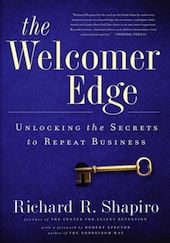The Secret of Lousy Service and Why it Happens
QUESTION: Why does lousy service occur?
ANSWER: Lousy service happens because (big) companies don’t understand people OR training.
I am amazed at how many times someone in a service environment delivers lousy service. And it’s often not just lousy – add rude, offensive, abrasive, defensive, maddening, and most of all disappointing.
GREAT NEWS: It doesn’t have to be like that.
If I take the time to complain, which I rarely do anymore, the manager will always ask, “Did you get the name of the person?” Somehow getting the name of the person is important to the manager. But it is unimportant to me. I never get their name.
The manager is looking to blame someone. I’m looking for someone to accept responsibility. The manager is NEVER the one who takes it.
I have found poor service is a reflection of the company and its leaders, not just the person who delivered it.
MY REALITY: When a manager asks me for the person’s name who delivered lousy service, I reply, “Don’t yell at the person who gave me lousy service. Yell at the person who trained them.” The person delivering poor service is most likely to have been poorly trained or ill trained, or both. They’re doing what they were trained to do, and say what they were trained to say.
Or the employee will ‘modify training’ and make statements based on their ‘at the moment’ feelings:
- Sorry about that…
- That’s our policy…
- I’m just doing my job…
- They don’t pay me to think…
- I’m just a peon…
Or worse, they become defensive, even rude, when a customer expresses frustration or anger as a reaction to what happened. Employees do that because someone TAUGHT THEM they don’t have to take gruff from a customer. (REALITY: The customer provides the money for their paycheck).
Ever get poor service at an airline? Of course you have, EVERYONE HAS. It happens because the people who work at the airlines are undertrained, poorly managed, feel put upon by their management and their leadership, underpaid, rarely if ever praised, and are exposed to constant customer complaints. They don’t like their job, they don’t like or respect their leader, they don’t like their company, and they don’t like the people they serve. Not good.
Now granted, this is a generalization, but I’m in the air enough to make the comment based on 20 years of flying experience. I get an occasional nice person. I have an occasional pleasant experience. But they are so rare that I actually go up to the person and thank them for being nice, for being happy, and for being friendly.
So let’s get back to the question at hand. Why does lousy service exist?
Who is responsible to make great service possible?
Who is responsible to make great service happen?
I always ask people in service positions, “How’s it going?” Most people respond in some negative fashion. Statements like, “Well, tomorrow is Friday!” or “I’ll let you know in two hours when I get off.” or “You’re kidding, right?”
These are losing, self-defeating statements. Statements made by people who fail to understand that doing their best, having a great attitude, and having a high sense of personal pride have nothing to do with the job. They have everything to do with who you are as a person.
Most of the front-line servers are in low-paying positions. When you combine that with our “feeling of entitlement” workforce and with training that’s all about the company, with a smattering of, “smile, greet the customer, thank the customer,” you have a perfect setting for mediocre or lousy service to occur most of the time.
About now, you want answers to this dilemma. I have them. They revolve around four words you already know: positive attitude and personal pride. But there is way more to these four words than your known definition.
Positive attitude and personal pride hold the key to your success, and they will be discussed in-depth next week.
Reprinted with permission from Jeffrey H. Gitomer and Buy Gitomer.
About the Author


